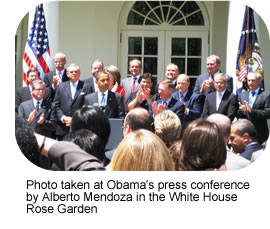
By John Addison (updated 9/7/10).
President Barack Obama announced that automakers must meet U.S. fuel-economy standards that require new cars and light trucks to average 35.5 miles per gallon by 2016. Several 2010 cars already beat 35.5 mpg such as the Ford Fusion Hybrid, Mercury Milan Hybrid, Toyota Prius, Honda Insight, Honda Civic Hybrid, and the Mercedes Smart Fortwo. In 2011, many new hybrids, plug-in hybrids, and electric cars will be sold that exceed the 2016 standards.
In Europe, over 100 models can be purchased that meet the 2016 standards, thanks to the popularity of cars that are smaller, lighter weight, and often use efficient turbo diesel engines.
Over the next three years, dozens of exciting cars will be introduced in the United States. Here are some offerings that we are likely to see in the next one to three years from major auto makers.
Ford will extend its current hybrid success with added models. During my recent test-drive of several vehicles that meet the 2016 requirement the midsized Ford Fusion Hybrid demonstrates that you can enjoy fuel economy in a larger car with comfort and safety. The Ford Fusion Hybrid has an EPA certified rating of 41 mpg in the city and 36 mpg on the highway. The car can be driven up to 47 mph in electric mode with no gasoline being consumed. Ford will start selling pure battery electric vehicles next year.
In discussing the new standards, Ford CEO Alan Mulally stated, “We are pleased President Obama is taking decisive and positive action as we work together toward one national standard for vehicle fuel economy and greenhouse gas emissions that will benefit the environment and the economy.”
General Motors plans to be the leader in plug-in hybrids starting with the Chevy Volt. It has a major opportunity to extend its voltage architecture to SUVs and trucks by 2016.
There are almost 40,000 Chrysler GEM electric vehicles in use today. The GEM 25 mph speed limits them to only being popular in fleets, university towns, and retirement communities. Chrysler’s new major stockholder will bring in exciting smaller cars such as the Fiat 500 and Fiat 500 Electric.
Toyota will expand on the success of the Prius with more new hybrids. Since 2002, I have been driving a Prius that has averaged 41 mpg in real world driving that has included climbing hills with bikes on a roof rack and driving through snow with skis on the roof rack. The Prius will also be made available as a plug-in hybrid – hundreds of these PHEVs are now being tested by fleets. The modestly priced Yaris, which gets 32 mpg, will also be offered as a hybrid that delivers over 40 mpg.
Honda is likely to be the first maker to meet 2016 CAFÉ requirements, building on its historical leadership in fuel economy. Honda now offers the Civic Hybrid and the Insight hybrid. In the future, Honda will offer a Fit Hybrid, a plug-in hybrid, and a battery-electric car.
Nissan’s Altima Hybrid delivers an impressive 34 mpg. Beyond hybrids, Nissan is determined to be the leader in battery electric vehicles and deliver over 20,000 of the Nissan LEAF in 2011. Clean Fleet Report EV Test Drive
Meeting the CAFÉ standards by 2016 will not be easy for all of the automakers, but they will make it. Historically, CAFE standards have not aligned with the EPA fuel economy determinations used in this article. For better and worse, flexfuel vehicles get artificially high numbers, making it easier for GM, Ford, and Chrysler to meet CAFE targets. Plug-in hybrid and electric car ratings need to be finalized.
Trends to more efficient drive systems are a certainty. With oil prices over double the lows of 2009, these new vehicles bring important relief to every driver who wants to save at the pump.
http://www.youtube.com/watch?v=TIdVvPMi8HY
